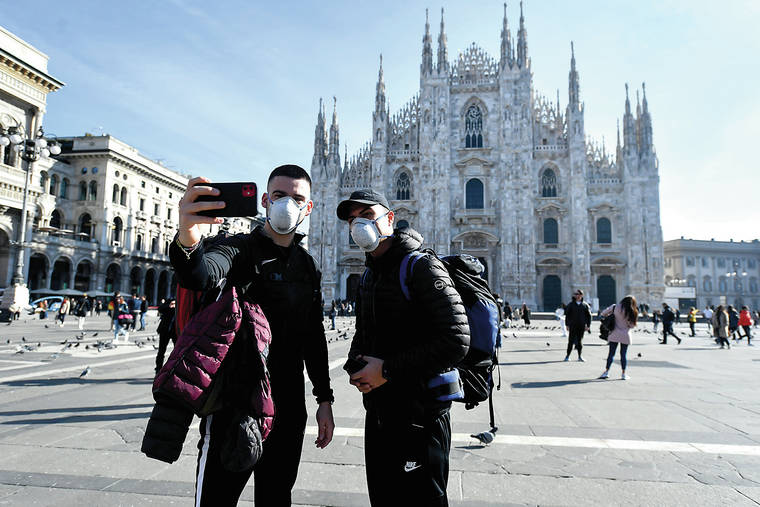COVID-19, the recently identified respiratory illness that has infected thousands in China and elsewhere around the world, could bring “considerable” but uncertain risk to Hawaii’s tourism and economy in the coming year, according to a forecast published Monday by the University of Hawaii’s Economic Research Organization.
“The coronavirus presents the risk of substantial disruption to Hawaii travel, particularly from international markets,” the forecast reads.
In the first half of February alone, the report states the number of international passengers from countries other than Japan dropped 21% below the prior year levels, and it assumes there will be no arrivals from China until the third quarter of 2020.
Travel restrictions intended to limit the spread of the virus have a direct impact on tourism, while choices potential travelers make are indirect impacts.
Ross Birch, executive director of the Island of Hawaii Visitors Bureau, declined to comment about Big Island tourism impacts and directed questions to the Hawaii Tourism Authority.
A spokeswoman for HTA did not respond to emailed questions, but recommended the Tribune-Herald ask questions about the impact of the virus to those in the tourism industry.
Yosh Sato, part owner of Hilo-based Maikai Ohana Tours, said his company offers tours to Japan but largely provides tours here for Japanese tourists.
While they’ve had some cancellations for tours to Japan planned in April, Sato said they’ve not yet seen any significant impacts from the coronavirus outbreak.
State tourism officials said last month that fewer than 1% of visitors to Hawaii came from China last year.
“The more important unknown is whether virus concerns will also cause a sharp falloff in Japanese travelers,” the forecast reads. “So far that is not evident, but past experience raises concerns.”
Based on past epidemics originating in China, UHERO predicts Hawaii may see a temporary decline in the number of visitors from Japan and other markets.
During the 2003 outbreak of Severe Acute Respiratory Syndrome, another coronavirus, UHERO said there was a temporary 25% decline in visitors from “non-primary” markets and a 40% decline in Japanese visitors, while domestic arrivals rose.
“Our scenario for the impact of COVID-19 assumes a similar path forward,” the UHERO report reads. “Arrivals from Japan bottom out in the second quarter, nearly 30% below year-earlier levels, but they fully recover by the first quarter in 2021.”
The number of visitors from non-traditional visitor markets, like China, are predicted to see a 15% decline in the second quarter before making a gradual recovery.
“Arrivals from the U.S. remain close to the baseline forecast as any potential loss is offset by visitors choosing Hawaii over more exposed Asian destinations,” the report reads.
“The overall impact is to reduce total arrivals by about 230,000 visitors in the first half of the year, recovering fully by the third quarter.”
Because the outbreak was “recognized gradually” and it is costly to cancel flights, “the economic impact may ramp up over time,” UHERO states.
Additionally, UHERO said that media coverage of the outbreak lowers travel demand “as would-be airline (and cruise ship) passengers opt to avoid tight spaces shared with others or the risk of quarantines abroad.”
Dozens of Americans on the Princess Cruiseline’s Diamond Princess, which was quarantined off the coast of Japan until last week, have tested positive for COVID-19.
According to the state Department of Health, American passengers from the Diamond Princess have been flown to bases in California and Texas for a two-week quarantine, but the DOH has no information about passengers who are Hawaii residents.
The DOH also has been notified of at least four Hawaii residents who were passengers on the Holland America Line’s Westerdam cruise ship.
Time magazine reported that an American woman aboard the Westerdam had initially tested positive for the COVID-19 in Malaysia, but that test result was a false positive.
Tests on 1,500 other passengers also came back negative, the outlet reported.
More than 80,000 cases, largely in China — where the virus was first detected Dec. 31 — have been confirmed, including 53 in the United States.
Around 2,700 deaths have been reported.
There are no reported cases of COVID-19 in Hawaii, but as of Tuesday, 58 individuals are self-monitoring under the supervision of state public health officials, including four on Hawaii Island.
Email Stephanie Salmons at ssalmons@hawaiitribune-herald.com.






